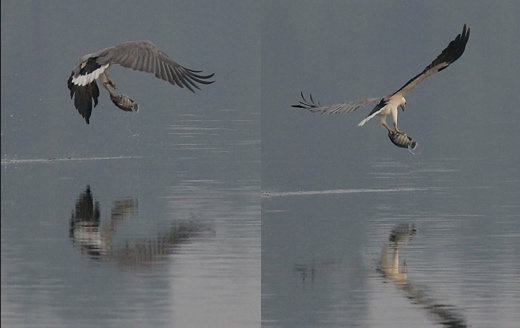The White-bellied Sea Eagle (Haliaeetus leucogaster) is a great fishing bird. It sits quietly on a high perch near water and patiently waits. The moment it spots a fish swimming near the surface of the water nearby, it immediately takes flight and zoomed in on the target. Once within grabbing distance, it pounces on the fish, barely breaking the water surface (left). Normally, only its feet and legs get immersed in the water. But once in a while more of the bird may be submerged, sometimes even the entire bird.
Once caught within the powerful grasp of its talons, the fish is carried with one foot back to its favourite perch to be eaten (bottom).
The sea eagle feeds mainly on aquatic vertebrates like reptiles (sea snakes, small turtles and tortoises), fish, water birds (gulls, terns, young of herons, ducks, geese), crustaceans and small mammals. But it is an opportunistic feeder. Once in a while it snatches fruit bats from their roosts. It has also been known to catch a rat that was swimming near the coast off Changi.
The bird has a pair of long, broad wings that are an advantage for soaring and gliding. They also come in useful in providing lift, especially after catching a heavy load of fish, as seen the the images below. The tail is just a slender appendage and wedged. Its main function is mainly to assist in maneuvering and steering within confined spaces like in a forest. But sea eagle hunting mostly in open water does not need to manoeuver.
The feet of the bird is stout and strong, with long, prominently curved claws, the better to grip on to the slippery fish. After grabbing the fish from the surface of the water with its left foot, the powerful down stroke of the wings provide instant lift (below).
Subsequent powerful flappings of the wings allowed it to rise well above the water (below). It flew to its perch where the fish was consumed.
Input by YC and images by Chan Yoke Meng.












3 Responses
Really beautiful pictures. Impressive to see such a majestic bird still being able to survive alongside people.
I’m aware that amongst is close relatives, the African fish eagle will take flamingos, and bald eagles and Steller’s sea eagles scavenge a lot when salmon return to the rivers to spawn; how similar is the white-bellied sea eagle in this regard? I know of the post where one tried to capture a grey heron, and another post where one caught a fruit bat, but how often have sea eagles been recorded taking large non-aquatic prey? Do they harass smaller birds to steal food as well?
I have observed the White-Billied Eagle in Singapore for the past month and on occasions, they do harassed the Grey Heron and snatch the food (fish) from them.
Lovely and graceful birds! I have just witnessed a pair in actions in front of roberston quay near alkaff bridge! One was circling high and the other swooping down to catch a fish!! Really breathtaking. Didn’t manage to take any photos as I wasn’t prepared to see them out here!